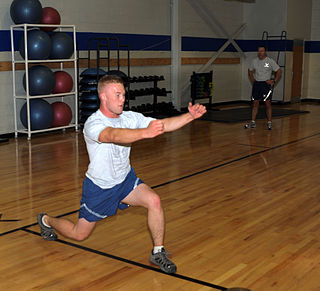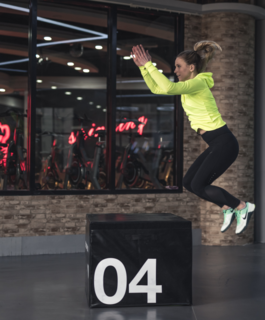
Weight training is a common type of strength training for developing the strength and size of skeletal muscles. It uses the force of gravity in the form of weighted bars, dumbbells or weight stacks in order to oppose the force generated by muscle through concentric or eccentric contraction. Weight training uses a variety of specialized equipment to target specific muscle groups and types of movement.

Calisthenics or callisthenics (/ˌkælɪsˈθɛnɪks/) is a form of strength training consisting of a variety of movements that exercise large muscle groups, such as standing, grasping, pushing, etc. These exercises are often performed rhythmically and with minimal equipment, as bodyweight exercises. They are intended to increase strength, fitness, and flexibility, through movements such as pulling, pushing, bending, jumping, or swinging, using one's body weight for resistance. Calisthenics can provide the benefits of muscular and aerobic conditioning, in addition to improving psychomotor skills such as balance, agility, and coordination. A study done in 2017," The effects of a calisthenics training intervention on posture, strength and body composition", by a group of scientists who found that calisthenics training is an "effective training solution to improve posture, strength and body composition without the use of any major training equipment".

The clean and jerk is a composite of two weightlifting movements, most often performed with a barbell: the clean and the jerk. During the clean, the lifter moves the barbell from the floor to a racked position across the deltoids, without resting fully on the clavicles. During the jerk, the lifter raises the barbell to a stationary position above the head, finishing with straight arms and legs, and the feet in the same plane as the torso and barbell.

Strength training or resistance training involves the performance of physical exercises which are designed to improve strength and endurance. It is often associated with the use of weights. It can also incorporate a variety of training techniques such as calisthenics, isometrics, and plyometrics.

A squat is a strength exercise in which the trainee lowers their hips from a standing position and then stands back up. During the descent of a squat, the hip and knee joints flex while the ankle joint dorsiflexes; conversely the hip and knee joints extend and the ankle joint plantarflexes when standing up.

An isometric exercise is a form of exercise involving the static contraction of a muscle without any visible movement in the angle of the joint. The term "isometric" combines the Greek words isos (equal) and -metria (measuring), meaning that in these exercises the length of the muscle and the angle of the joint do not change, though contraction strength may be varied. This is in contrast to isotonic contractions, in which the contraction strength does not change, though the muscle length and joint angle do.

Plyometrics, also known as jump training or plyos, are exercises in which muscles exert maximum force in short intervals of time, with the goal of increasing power (speed-strength). This training focuses on learning to move from a muscle extension to a contraction in a rapid or "explosive" manner, such as in specialized repeated jumping. Plyometrics are primarily used by athletes, especially martial artists, sprinters, arm wrestlers and high jumpers, to improve performance, and are used in the fitness field to a much lesser degree.
The snatch is the first of two lifts contested in the sport of weightlifting followed by the clean and jerk. The objective of the snatch is to lift the barbell from the ground to overhead in one continuous motion. There are four main styles of snatch used: squat snatch, split snatch, power snatch, and muscle snatch. The squat snatch and split snatch are the most common styles used in competition while power snatch and muscle snatch are mostly used for training purposes.

The kettlebell is a cast iron or cast steel ball with a handle attached to the top. It is used to perform many types of exercises, including ballistic exercises that combine cardiovascular, strength and flexibility training. They are also the primary equipment used in the weight lifting sport of kettlebell lifting.
Circuit training is a form of body conditioning that involves endurance training, resistance training, high-intensity aerobics, and exercises performed in a circuit, similar to high-intensity interval training. It targets strength building and muscular endurance. An exercise "circuit" is one completion of all set exercises in the program. When one circuit is completed, one begins the first exercise again for the next circuit. Traditionally, the time between exercises in circuit training is short and often with rapid movement to the next exercise.
Complex training, also known as contrast training or post-activation potentiation training, involves the integration of strength training and plyometrics in a training system designed to improve explosive power. According to Jace Derwin:
Strength training and plyometric training are both effective measures for increasing athletic performance independent of each other, but a true program designed for power-based athletes needs to incorporate both disciplines. A study done in 2000 in the NSCA's Journal of Strength and Conditioning Research measured three different training protocols: strength training, plyometric training, and a combination of both. The group that used combined methods was the only group that showed significant increases in BOTH strength and power.
Closed kinetic chain exercises or closed chain exercises (CKC) are physical exercises performed where the hand or foot is fixed in space and cannot move. The extremity remains in constant contact with the immobile surface, usually the ground or the base of a machine.
Tudor Olimpius Bompa is a sports scientist. He is a Professor Emeritus at York University in Toronto, Ontario, Canada. He is married to Tamara Bompa, who is an associate lecturer at York University.

A lunge can refer to any position of the human body where one leg is positioned forward with knee bent and foot flat on the ground while the other leg is positioned behind. It is used by athletes in cross-training for sports, by weight-trainers as a fitness exercise, and by practitioners of yoga as part of an asana regimen.

A vertical jump or vertical leap is the act of jumping upwards into the air. It can be an exercise for building both endurance and strength, and is also a standard test for measuring athletic performance. It may also be referred to as a Sargent jump, named for Dudley Allen Sargent.

The following outline is provided as an overview of and topical guide to exercise:
BodyAttack is a commercial group-fitness sports inspired cardio workout program including some sports-derived movements, aimed primarily at developing cardiovascular fitness. The program is created and distributed by Les Mills International. There is a release with new music and movements every three months. In the UK it is offered at around 1,300 health and fitness facilities, approximately one fifth of such facilities in the country. It consists of a standardized class that is either 55, 45 or 30 minutes in length, led by a certified instructor who leads participants through various exercises to a contemporary music soundtrack. Like BodyPump and other Les Mills programs, the movements, exercises and music are standardized for all instructors. The aim is to develop numerous domains of physical fitness, particularly cardiovascular fitness and stamina.

A kick is a skill in association football in which a player strikes the ball with their foot. Association football, more commonly referred to as football and also known as soccer, is a sport played world-wide, with up to 265 million people around the world participating on a yearly basis. Kicking is one of the most difficult skills to acquire in football. This skill is also vitally important, as kicking is the way in which passes are made and the primary means by which goals are scored.

Power training typically involves exercises which apply the maximum amount of force as fast as possible; on the basis that strength + speed = power. Jumping with weights or throwing weights are two examples of power training exercises. Regular weight training exercises such as the clean and jerk and power clean may also be considered as being power training exercises due to the explosive speed required to complete the lifts. Power training may also involve contrasting exercises such as heavy lifts and plyometrics, known as complex training, in an attempt to combine the maximal lifting exertions with dynamic movements. This combination of a high strength exercise with a high speed exercise may lead to an increased ability to apply power. Power training frequently specifically utilises two physiological processes which increase in conjunction with one another during exercise. These are deep breathing, which results in increased intra-abdominal pressure; and post-activation potentation, which is the enhanced activation of the nervous system and increased muscle fibre recruitment. Power training programmes may be shaped to increase the trainee's ability to apply power in general, to meet sports specific criteria, or both.
Physical training has been present in human societies throughout history. Usually, it was performed for the purposes of preparing for physical competition or display, improving physical, emotional and mental health, and looking attractive. It took a variety of different forms but quick dynamic exercises were favoured over slow or more static ones. For example, running, jumping, wrestling, gymnastics and throwing heavy stones are mentioned frequently in historical sources and emphasised as being highly effective training methods. Notably, they are also forms of exercise which are readily achievable for most people to some extent or another.












